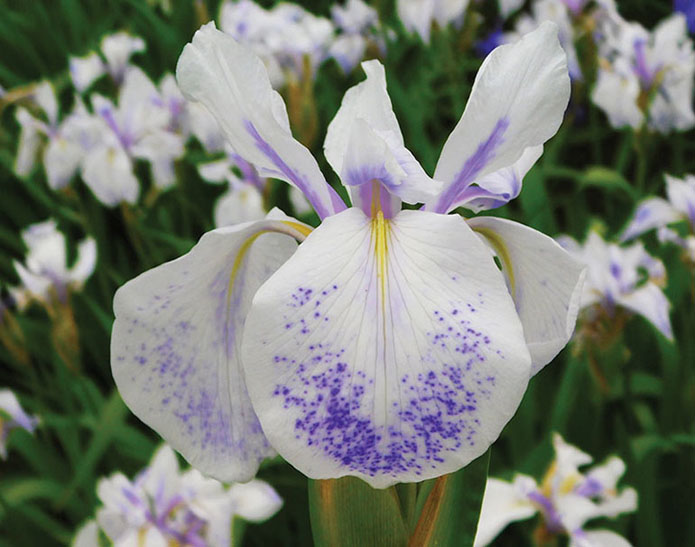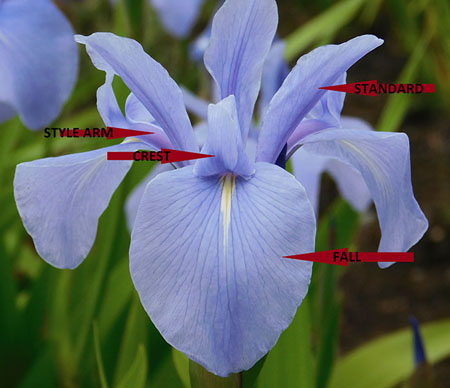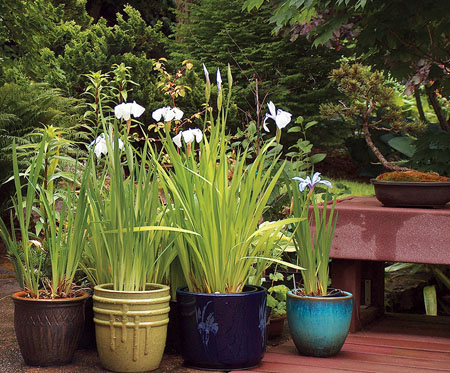
Whether natural or man-made, there are many different water-garden irises that can grow in and around your pond. Iris laevigata is related to many of the water-loving irises found in the laevigatae series. This series includes irises found across the world: the United States’ two natives (Iris virginica and Iris versicolor), Europe’s yellow-flag Iris pseudacorus, Asia’s Iris maackii and Iris ensata, better known as the Japanese iris. Iris laevigata, well known in Japan as kakitsubata and in China as yan-zi-hua, is found native in northern Japan and across eastern Asia to Siberia’s Lake Baikal, where it was initially found around 1770 by botanist P.S. Pallas. It must be noted, though, that written poems naming this iris in Japan date back to 760 A.D. Due to its native temperature ranges, this iris can be grown throughout USDA zones 3 to 9 with little care.
Many of the water-loving irises are marginal plants and need special siting, with their roots reaching water and crowns growing above the water line. If the crown is below the water line with a heavy winter freeze, major loss may be experienced due to suffocation. Iris laevigata, however, is more versatile and able to grow at the edge of a natural pond both above the water line and slightly deeper, to the point of being totally submerged. This trait lends itself to being an excellent candidate for a container-grown plant slightly submerged in a man-made pond. The smaller stature of Iris laevigata also lends itself to be grown in a container; however, a minimum of 3 to 5 gallons should be used. This will reduce need for transplanting to every three or four years; plus, this adds stability to the container, keeping it from tipping over. In a natural pond, transplanting may not be necessary while the plant finds its own space during naturalization. I have grown Iris laevigata ‘Semperflorens’ at our natural pond for more than 20 years with no extra care aside from weeding grasses and ferns from the crown.
>> Pond Trends | Perks of Customer Relationship Management Software
Many have said that the bloom season of irises is too short. However, the nature of Iris laevigata — sending up several blooms per bud, blooming one at a time and lasting three days each — will usually find the plant blooming for three to four weeks. I am also finding with my breeding program that different strains bloom earlier and later, so you can help extend the season by growing two or more varietals. An even larger extension of the bloom season can be made by adding its cousins, Iris ensata and a new hybrid ‘Pseudata,’ to your mix of plantings, as they bloom a full month later.
Parts of the Iris

The basic flower form of Iris laevigata is the same for others in the iris family, with multiples of three standards, falls and style arms with crests. The easy way to remember the parts of an iris flower are to think, “standing standards,” “falling falls” and “your coat of style arms with the family crests at your heart.”
Flower parts can be changed up with some irises, most notably with Iris laevigata and Iris ensata, by converting the standards into a second layering of falls, thus making a double flower with no standards and six falls. The bloom of Iris laevigata can be 4 to 6 inches across, making for a magnificent display close and far. Colors are limited to alba-white, red-violet and blue-violet, and they can be found in all shades, from deep-royals to pastels. The many different dotted patterns mixed with the various shades make for an almost unlimited array of colors and patterns.
While the plant is remarkable in bloom, we also need to direct our attention to the plant as a whole. In my garden talks, I have a saying: “The bloom to the plant is like icing on a cake.” The plant is the foundation. It needs to have strength and look good throughout the growing season. The bloom is a bonus. The unique, soft, lime-green foliage of Iris laevigata is very handsome. The natural arching fountain forms at 1 to 2 feet tall, and individual blades of the foliage form at 2 to 3 inches across, making this plant a real standout for the water garden.
Tips & Tricks

Site this plant in full sun to partial shade. In a natural pond, plant at the water’s edge and let it find its own depth. In the man-made pond, an elevated container may be used. At first, it is advisable to start the newly acquired plants with the rhizome above the water line to prevent rotting. After new growth and roots start to anchor, the container may be lowered and covered by 1 to 2 inches of water. If you wish to have the handsome foliage and bloom next to the pond and not directly in the water, it is recommended to double-pot it — planting it in a poly-container and dropping it into a larger decorative container. The decorative container thus serves two purposes: to act as a sun shield for the roots in the poly-container, and to give a decorative look for enjoyment.
Winter care for these very hardy plants is simple. If grown in a natural pond, let it be. In a submerged container, let it be. If the container is out of the water in mild areas, they can be left out all winter. In colder areas, the poly-container should be buried in the garden to mulch the plant. The decorative container should be brought in to a protective dry area for winter storage.
Iris laevigata for many centuries has been grown and admired throughout northern Asia. With simple beauty, ease of growth and hardiness, does it not demand a space in your garden as well?


